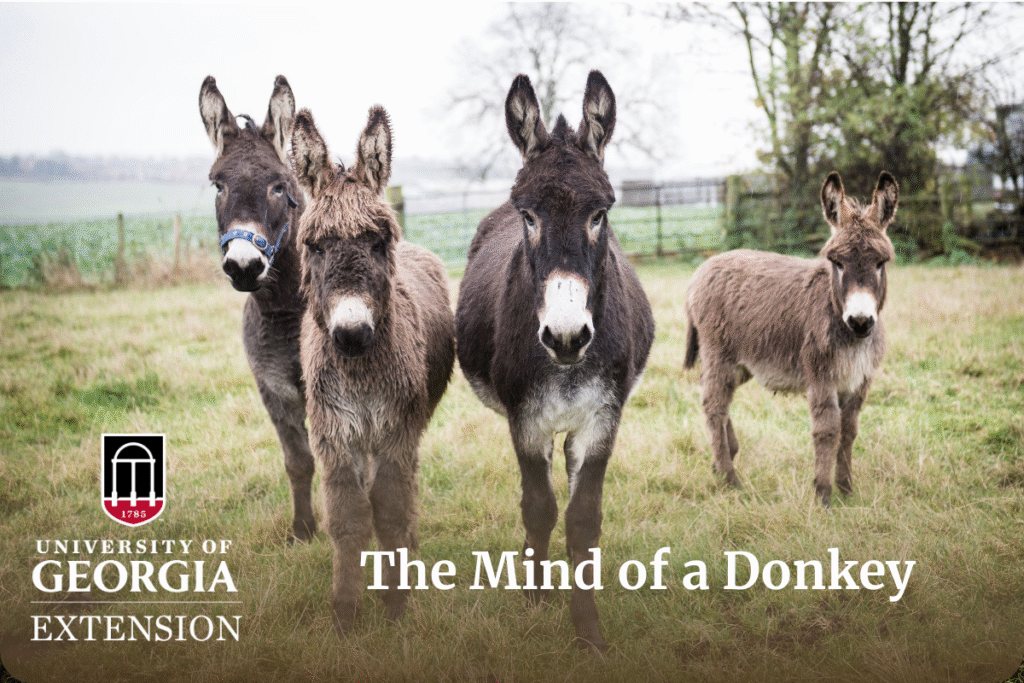
Donkeys are not small horses with long ears. They evolved in arid, mountainous regions where survival depended on careful decision-making and strong self-preservation. Instead of reacting quickly like a flighty horse, a donkey stops to assess a situation before moving forward.
Key traits of donkey behavior include:
- Deliberate thinking. When faced with something new, a donkey may pause, plant its feet, and observe. This is not defiance; it is problem-solving.
- Strong memory. Donkeys remember people, places, and experiences whether good or bad. A positive interaction can build lasting trust, while a single harsh experience may create a lasting fear. (Monzar can definitely hold a grudge.)
- Bonding instinct. Donkeys are deeply social and form close relationships with their herd and their handler. Trust is the foundation for cooperation.
Building Trust First
When I first acquired Monzar, he was untouched and I had to run him off the trailer through my barn and into the pasture. I could not catch him and he had no interest in treats or even feed. His flight zone was about 25 yards and even running him into the barn yard was difficult. That is when I decided to not rush and approach things differently. Because donkeys value safety and relationships, the first step in training is always trust. Rushing this stage is counterproductive. It took about six months of consistently sitting in my pasture before I was able to touch Monzar as a young 2 yr old untouched donkey.
- Spend quiet time together. Simply being in the pasture, brushing, or offering gentle scratches lets the donkey learn that you are safe.
- Be consistent. Donkeys thrive on routine and clear signals. Sudden changes or unpredictable handling create anxiety.
- Reward calm behavior. A kind word, a soft rub, or a small treat reinforces good choices and encourages curiosity.
Training Principles
Once a bond is established, training can progress steadily using calm, positive methods. Monzar will confidently load in a trailer and even walk through doors into a local high school classroom.
- Start with the basics. Teach haltering, leading, and tying with patience. Expect pauses while the donkey processes new tasks.
- Use pressure and release. A light, steady cue with the lead rope or with a driving line should be released the moment the donkey responds. This clarity teaches them how to find the correct answer.
- Keep sessions short. Ten to fifteen minutes of focused work is often enough. End on a good note to build confidence.
- Expose gradually. Introduce new sights and sounds at a pace the donkey can handle, rewarding curiosity and calmness.
Common Training Goals
Donkeys can be trained for a variety of activities, from practical farm work to enjoyable hobbies.
- Companion and therapy animals. Their calm nature and steady temperament make them wonderful partners for children and therapy programs.
- Packing and trail work. Donkeys are natural hikers and can carry supplies with proper conditioning.
- Driving. Many donkeys excel in harness, pulling carts or participating in pleasure driving competitions.
- Obstacle and agility courses. These games engage their intelligence and natural curiosity.
Handling Challenges
Some behaviors, such as refusal to move or sudden braying, are usually signs of discomfort or uncertainty. Before assuming disobedience:
- Check for physical issues like sore feet or ill-fitting tack.
- Review whether the task was introduced too quickly.
- Give the donkey time to think and offer gentle encouragement.
The Reward of Patience
Training a donkey is not about domination; it is about partnership. When treated with kindness and respect, donkeys become remarkably willing, affectionate animals. Their loyalty and intelligence create a bond that often surpasses that of other livestock.
Approach training as a conversation, not a contest. With trust, consistency, and a little creativity, you will discover that the so-called stubborn donkey is actually one of the most thoughtful and rewarding animals to work with. I know I have enjoyed getting to do something new with my donkey and hopefully not driving him too crazy.
Additional Donkey Behavior Resources:
Let’s Talk Donkeys: Behavioral and Nutritional Management from Penn State